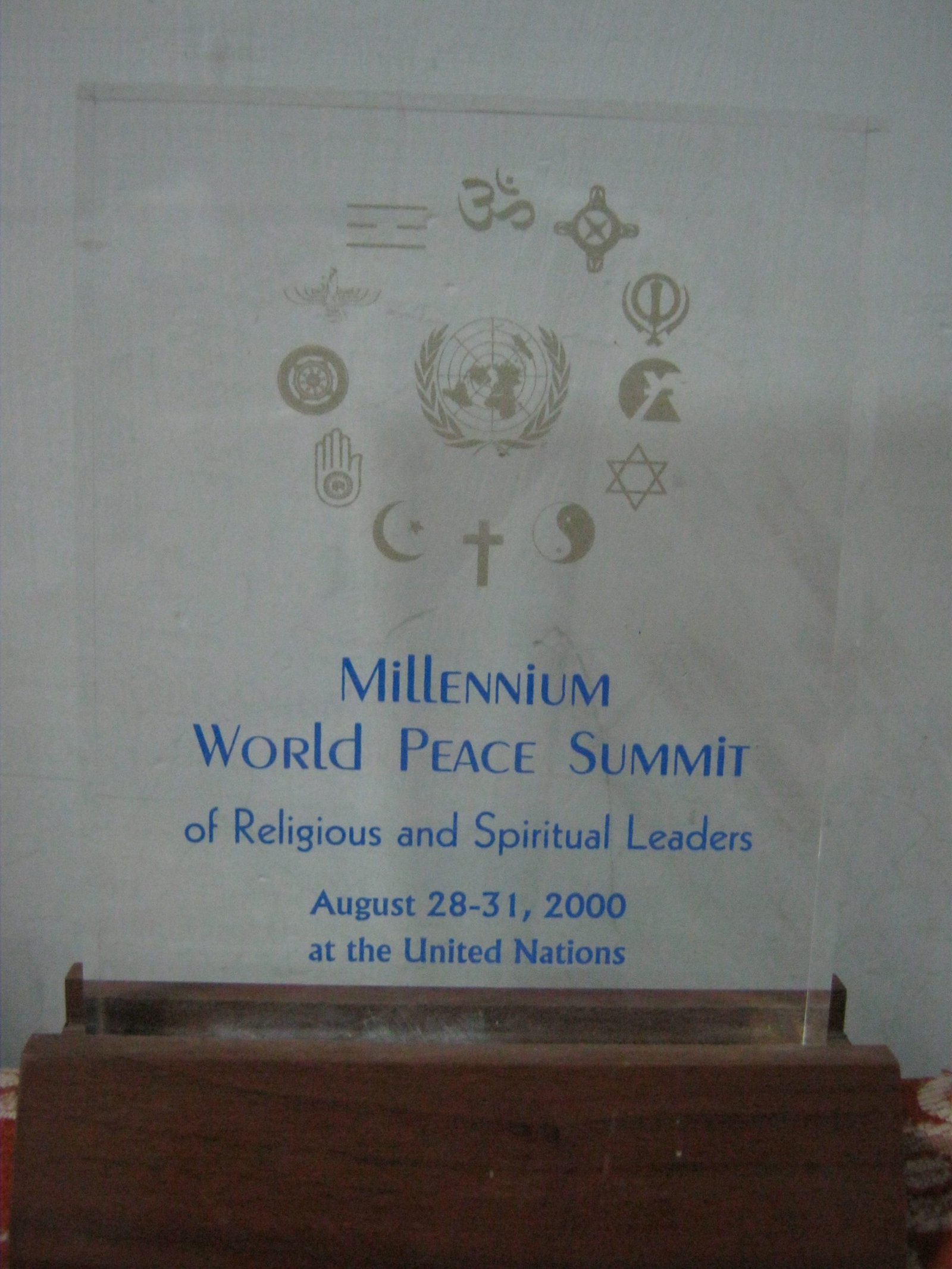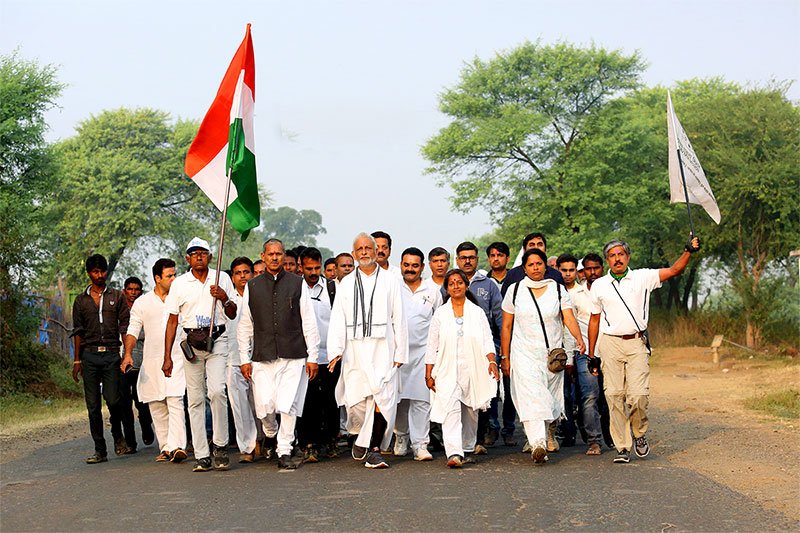Excerpt from the Talk at the Millennium World Peace Summit of Religious and Spiritual Leaders at the United Nations, August 28, 2000.
Mere social reforms however, cannot do much as we have seen in the past. What is required is the reformation and change, which is the natural outcome of the individual’s spiritual experience of inner unity, which again comes with the realization, that every human soul is potentially a spark of the divine Supreme Reality, or at least is linked to that Being, who for want of a better word we call God.

If this inner conviction, which the great religions of the world and the great spiritual teachers have spoken about — nicely summed up by the words of the great teacher of Galilee, “Blessed are the peacemakers for they shall be called the children of God.” Or the famous statement in the epistles of St. Paul, his disciple, “Know ye not that ye are the children of the living God and the spirit of God dwelleth in ye”— can be translated into action, world peace which is the end of war, is not far away.
I must remind all our friends who have gathered here that every religion subscribes to the tenet of PEACE first and foremost. When a Muslim meets another, the first greeting is, “Salaam alaikum ( may the peace of the Lord be upon you)”. “Shalom (peace),” says the representative of the ancient Jewish religion. Every prayer of the great Hindu heritage ends with, “OM Shanti (OM peace)”. For, peace is the very foundation and fabric of human coexistence.
The great religions of the world all admit that spiritual teachers and prophets have arisen in all parts of the world for thousands of years and have taught each race and generation, as the Sufis say, “According to their needs and according to their capacities.” The four thousand year old Rigveda, one of the sacred works of the Hindus puts it succinctly when it says, “ Ekam Sat vipra bahuda vedanti,” — the truth is one, wise men call it by many names.
If the world’s religious and spiritual leaders keep this in mind and consider peace and human welfare as the crux of religion and spirituality, then the very lives we lead will contribute to peace. We can, then, without the least trace of hypocrisy or greed for power and position, guide and direct the people to take practical steps to bring about world peace and end war.
Only the truly religious, who are free from the greed for power and position can inspire true reform and galvanize the masses to shun war and strive for lasting peace. Only when the heart is pure (Blessed are the pure in heart for they shall see God — New Testament) and unselfish, does the concern and compassion for fellow humans arise. In the words of the Bhagawad Gita, another great book of Hindustan, the country where I come from, ”He who seeks the welfare of all living beings is the greatest practitioner of religion.” The great Swami Vivekananda was a perfect example of such a practitioner of religion in the recent past.
One of the oldest religions of India, Jainism, has in fact made non-violence the most important creed of their faith: ‘Ahimsa paramo dharma’ (non- violence is the greatest religion) declared their Tirthankaras (Perfected teachers). And, we all know how important non- violence was to the great Buddha.
No wonder that attempts to end war by the professedly agnostic and atheistic leaders have failed miserably, since they lack the tremendous energy that flows from the core of the consciousness of those who have true spiritual realization and the resultant deep inner conviction.
Therefore, it is the religious and spiritual leaders who must take the initiative and work in cooperation with the United Nations Organization to truly unite all the nations on the earth.
I believe that the U.N. would be doing a great service to the cause of inter-religious harmony and world peace, if it could set up a well-equipped center for the study of comparative religion or support such already existing centres.
Also, apart from the conferences at the U.N. headquarters, smaller conferences and meetings could be organized at national, state, and regional levels to bring together religious and spiritual leaders.
The U.N. could also organize and participate in rallies (Padayatras) for religious harmony like the ones the Manav Ekta Mission — a wing of the Satsang Foundation, of which the writer is the founder — has been organizing for the last few years.
Last, but not the least, all attempts to bridge the gap between religion and science should be encouraged.
In this age, when science is almost a religion and a scientist’s views are generally accepted by all the rational human beings, steps should be taken to bring scientists and religious and spiritual leaders together.
If facilities for research in such religio-scientific areas could be set up or supported, it is bound to mutually benefit the scientists, on the one hand, who will understand that the study and practise of ethics and religion is as much important as the study of physical sciences, or even that religion and meta- physics transcend the world of the senses; and the religious leaders on the on the other hand, who will learn to eliminate the superstitions and arrive at the purest form of religion and religious experience.
To conclude, let me invoke the ancient vedic prayer:
Lead me from the unreal to the real (Asato ma sad gamaya)
Lead me from darkness to light (Tamaso ma jyotir gamaya)
Lead me from death to immortality (Mrityor ma amritam gamaya)
Let there be peace peace peace (Om Shanti Shanti Shanti)
-Sri M

Sri M led the Walk of Hope, a padayatra for peace and harmony by the Manav Ekta Mission – which covered 7500 kms from Kanyakumari to Kashmir from Jan 2015 to April 2016. The journey spanned 16 months through 11 Indian states, bringing together more than 10 million fellow citizens from all walks of life. Traversing the varied landscape of India, it sought a significantly restored nation—fit enough to be bequeathed to our future generations.
The padayatra covered 15-20 kms a day and halted in the evening at a pre-determined village or town enroute. The evening was spent meeting with the local populace – which usually included meaningful dialogues, inter-faith prayers, eating together and, finally, resting overnight at their homes. A diverse assembly of responsible citizens, who foresaw a united and inclusive India for themselves and the future generations, accompanied Sri M in this walk.
The Walk of Hope was an exercise to restore the innate spirituality of the nation – rekindling true faith and rejuvenating the spirit of hope, love, peace, harmony and oneness. The hope was and still is to erase disparities arising from a misunderstanding of our diverse culture and religions, thus uniting the humanity of India through a spiritual approach proving people can live together despite all differences.
Videos
Speech by Mr Adama Dieng at the International summit on Peace & Harmony during Walk of Hope 2015-16, led by Sri M
Chal Chalen – Official Music Video for the Walk of Hope 2015-16
Sri M’s speech – Walk of Hope 2015 – Flag off Ceremony – 12 Jan 2015
Sri M’s Speech – Conclusion of the Walk of Hope 2015-16

